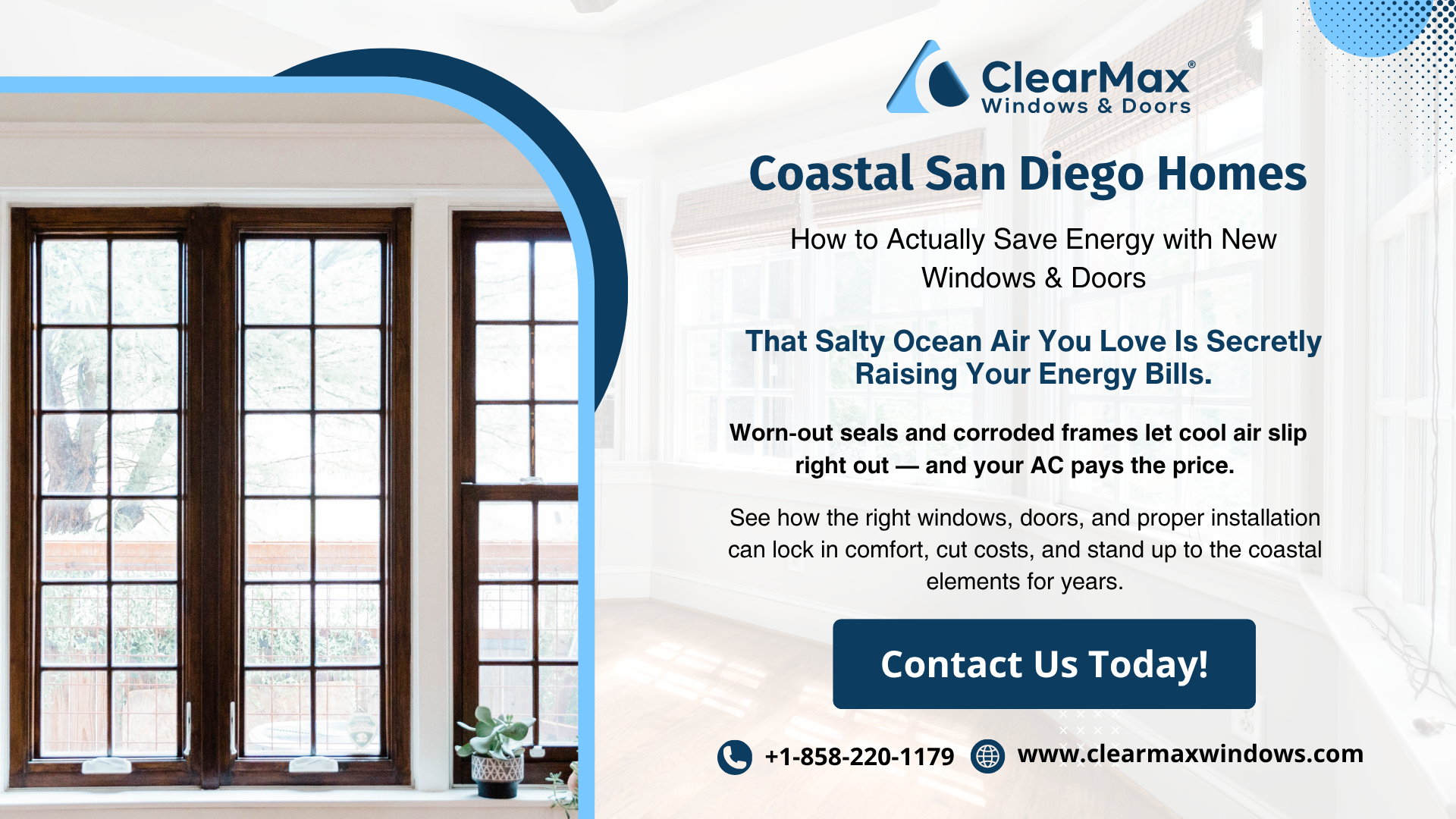How to Actually Save Energy with New Windows and Doors in Coastal San Diego

If you’ve lived near the coast for a while, you already know how the ocean has a mind of its own. One week it’s calm and perfect, the next it’s throwing salty air at your house like it’s in a mood. That same salt, sun, and breeze that make living here amazing also beat up your windows and doors more than you might think.
A lot of homeowners don’t connect the dots between their energy bills and those worn-out seals or foggy panes. But that’s where most of your heating and cooling is sneaking out. So, if your AC feels like it’s running overtime just to keep up, chances are the real problem isn’t the unit — it’s the openings around it.
Why Energy Efficiency Matters So Much by the Beach
San Diego weather looks easy: never too hot, never too cold. But the coastal mix of humidity, wind, and salt does slow, quiet damage. Frames swell, hardware rusts, and tiny gaps open up that let air slip through.
The continuous minor interchange of air between the outer and inner surfaces of the house is the reason your heating and cooling system has to work more and hence, your bills go up. The replacement of the outdated windows and doors with energy-efficient and modern ones controls the indoor temperature. The difference will be noticeable rather quickly – there will be no draft, lesser noise, and a house that remains cool when you want it to be.
What “Energy-Efficient” Really Means
People use that term as a badge of honor but let’s analyze the situation and clarify what really benefits:
- Low-E glass: A barely visible coating that bounces the sun’s heat away in summer and traps warmth inside when it’s cool.
- Double or triple panes: Gas-filled layers that make a quiet barrier against outside temperatures.
- Vinyl or fiberglass frames: Both stand up well to salt air. They don’t rust, and they’re low-maintenance.
- A proper install: Honestly, this one makes or breaks everything. The tightness of that seal is where your savings live.
None of it is magic. It’s just design done right for the climate we live in.
Coastal Air Is Beautiful but Brutal
That salty air doesn’t just smell good — it eats metal for breakfast. We’ve seen aluminum frames corrode within a few years, even if they looked fine from a distance. Fiberglass and vinyl, on the other hand, shrug it off like it’s nothing.
If your home sits within a few miles of the ocean, it’s not a bad idea to rinse your windows now and then. A quick hose-down helps remove salt film that can mess with your frames and seals.
Let’s Talk Numbers — How Much You Actually Save
Nobody wants to spend on replacements without knowing the payoff. The Department of Energy says most people save $125–$465 a year by swapping out single-pane windows for efficient ones. Around here, with AC running most of the year, you’re likely at the higher end of that range.
Add the federal 30 % tax credit and local rebates, and suddenly that project starts making real financial sense. Over a few years, the windows often pay for themselves — not to mention the comfort upgrade.
Picking What Works Best Near the Coast
Different homes, different needs, but some combos just work better for our climate:
| What You’re Choosing | Why | |
| Frame Material | Vinyl or Fiberglass | They won’t rust or warp in salty air |
| Glass Type | Low-E Double Pane | Blocks UV and heat without dimming the light |
| Window Style | Casement / Awning | Closes tight, less chance for air leaks |
| Doors | Vinyl Slider / Fiberglass French | Energy-efficient and durable |
If your home gets a lot of direct sunlight, go with Low-E2 or Low-E3 glass. It filters UV without making your rooms dark.
The Truth About Installation
You can buy the best window on the planet, and it’ll still waste energy if it’s installed wrong. We’ve seen gaps no one noticed until water started sneaking in months later.
That’s why it helps to have a crew that knows San Diego’s coastal quirks — things like how wind pressure shifts around a house or where salt tends to collect. At ClearMax, we measure twice, seal tight, and test every unit before wrapping up. You shouldn’t have to worry about it again for decades.
Keeping Them in Shape
The ocean’s great, but it’s not gentle. A little maintenance keeps your windows looking and performing like new:
- Spray them off with fresh water once in a while.
- Check the weatherstripping every year or two.
- Keep sliding tracks clear — sand loves to hide there.
- Wipe glass with a microfiber cloth to avoid scratching coatings.
Takes ten minutes, tops, and adds years to their life.
A Quick Story from a Local Homeowner
One of our clients in Point Loma replaced 14 old single-pane windows with vinyl double-pane units. The first summer after, she told us her home stayed six degrees cooler and her electric bill dropped by about 22 %.
No marketing fluff — just real-world results. That’s the kind of change you notice every single day.
Wrapping It Up
Coastal living is worth it. The air, the light, the views — there’s nothing like it. But those same perks can wear down your home faster than you think.
Swapping in energy-efficient windows and doors keeps your comfort high, your bills low, and your home protected from the coastal grind.
If your windows are older or starting to show fog or corrosion, maybe it’s time. Reach out to ClearMax Windows & Doors for a free estimate. We’ll help you find what fits your home, your style, and your budget — and we’ll make sure it’s done right.
ClearMax Windows & Doors
Serving San Diego and surrounding areas with quality products that actually last in coastal air.
That salty ocean air you love is secretly raising your energy bills. Worn-out seals and corroded frames let cool air slip right out — and your AC pays the price. See how the right windows, doors, and proper installation can lock in comfort, cut costs, and stand up to the coastal elements for years.
📧 info@clearmaxwindows.com | 📞 (858) 560-4300







